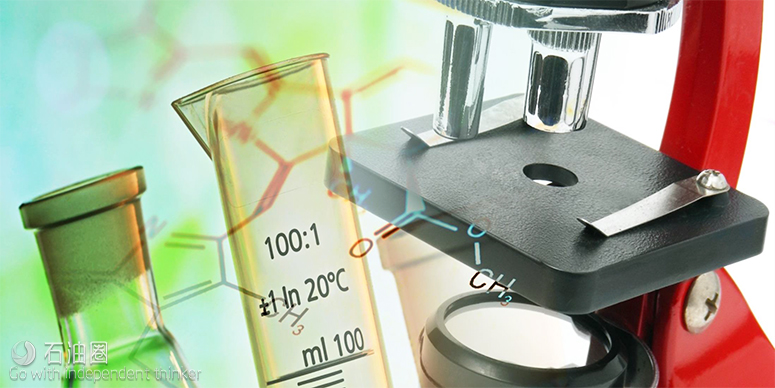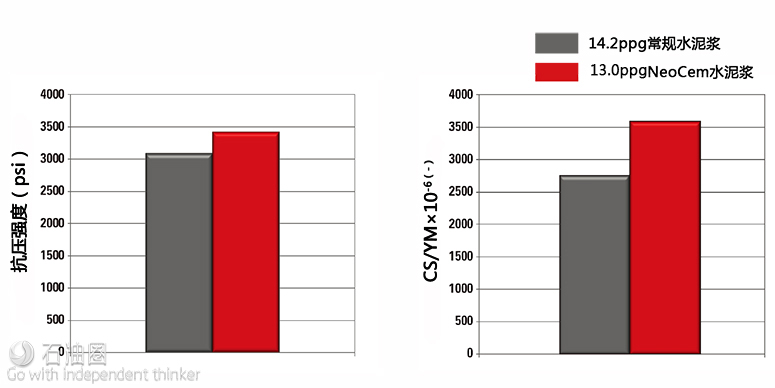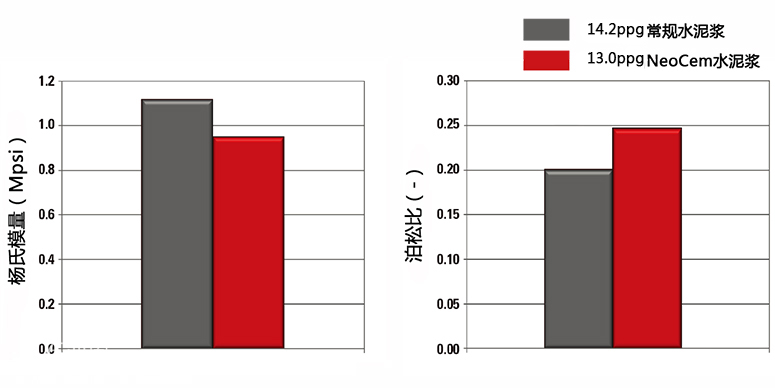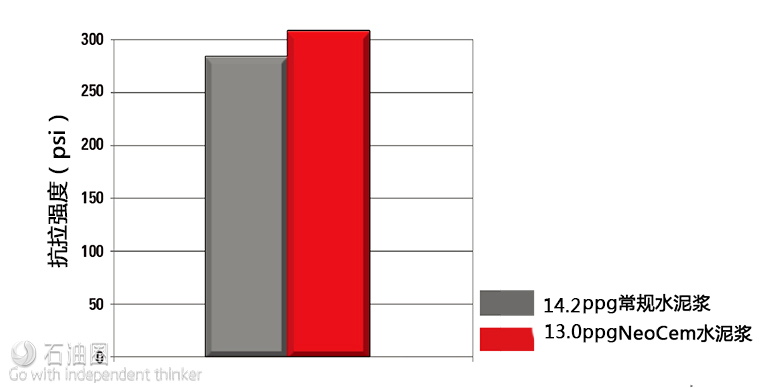NeoCem™ cement is a low-Portland cement system that delivers high-performance compressive strength, elasticity, and shear bond at a lower density than conventional cement systems. NeoCem cement is the result of Halliburton’s research and development team discovering synergies between the chemical and physical properties of specialized materials when combined with Portland cement. The NeoCem cement system is the first low-Portland oilfield cement system capable of improving the integrity of the hydraulic annular seal as well as the set-sheath elasticity.
In laboratory testing, performance properties of NeoCem cement were compared to a higher-density conventional oilfield cement systems. Conventionally, higher density cement systems typically demonstrate higher performance such as higher compressive strengths, while lower density cement systems generally present with reduced performance. However, when compared to a 1.2 lb/gal higher-density conventional oilfield cement system, the laboratory data indicates that NeoCem cement can deliver:
• Higher shear bond values by up to 79% improvement
• Compressive strength improvements up to 11%
• Up to 15% greater elasticity
• A compressive strength-to-Young’s-modulus ratio (CS/YM) that can be 30% higher than the 1.2-lb/gal higher-density conventional cement system.
Until now, higher-density cement systems have generally exhibited higher performance than lower density cement systems. Lower density cement systems are important for wells with narrow pressure margins or for cementing across weak formation zones.
There are essentially two states to consider for successfully achieving zonal isolation. The first is the dynamic state when the slurry is being placed in the annulus; the second is the static state, when the cement has set and formed a hydraulic seal between the formation and the casing. Poor performance during either state adds costs to your well. Only an optimized performance during each state is economical when so great an investment is involved.
NeoCem cement is particularly well suited for providing a dependable barrier in oilfield wells. The simplicity of the bulk material results in operational efficiency.
For the long term, NeoCem cement delivers annular barrier properties that help withstand cyclic loading from casing expansion and contraction during production and shut in and/ or the concussive forces during drilling and completion. The annular barrier should resist failure from deformation, fatigue from cycling loading, and corrosion, even though pressures and temperatures change throughout the life of the wells, sometimes by as much as 10,000 psi and hundreds of degrees, respectively.
Benefits
• Help manage equivalent circulating densities with a lower density cementing system while retaining key performance parameters.
• Achieve annular barrier properties that help withstand the downhole dynamic demands from continual pressure and temperature changes throughout the life of the well.
NeoCem™ Cement versus a Conventional Cement
Halliburton conducted extensive mechanical property testing in the laboratory to assess the performance of NeoCem™ cement. A conventional oil-well cement design was used for for baseline reference. Temperature (215ºF/102ºC and pressure (3,000 psi / 20.7MPa) were constant.
NeoCem cement presents a higher compressive strength (far left) plus up to a 30% ratio improvement (near left) between Compressive Strength (high for NeoCem Cement) and Young’s Modulus (low for NeoCem Cement) in spite of a density lower than the comparative conventional cement. These results indicate a significantly greater probability for NeoCem cement rather than conventional cement to withstanding cyclic loads from pressure events and resist cracking. NeoCem cement exhibits a lower Young’s modulus (far left) and a higher Poisson’s Ratio (near left), demonstrating greater ductility and thus a higher probability of resisting deformation due to casing expansion / contraction.
The dog bone test method allows for a stress concentration in the middle of the test sample for a higher probability that a rupture will occur there, validating both the test apparatus load and the sample. Tus, it is a more reliable methodology than the Brazilian test method for determining tensile strength.
From the Field
Challenge: Continental Resources experienced total losses when drilling the intermediate section of a well in North America. They asked Halliburton to help them overcome that in order to achieve planned top of cement and shoe joint integrity so that drilling the producing zone could proceed.
Solution: The lower density and enhanced performance capabilities of NeoCem™ cement.
Results: The hydrostatic load on the formation was reduced and cement was lifted past the loss zone to the planned top of cement as indicated by the bond log, which also verified the shoe joint integrity.
Case study
South Central Oklahoma Oil Province (SCOOP)
CHALLENGES
Operator was challenged with achieving consistent results for the intermediate casing string
Weak formation(s) caused significant losses during drilling and through cement job
Achieving designed top of cement proved inconsistent
Cement integrity paramount due to Formation Integrity Test (FIT) requirements for drill ahead operations
SOLUTIONS
Meeting customer requirements
-Lower density
-Equivalent or better mechanical properties
From historical modeling, it was determined that conventional cement blends could not solve existing problem
New technology was applied which could improve results in the area
iCem® Service modeling validated design changes
RESULTS
Reduced hydrostatic load on the formation and cemented past the loss zone
Full returns were observed throughout job
Good bond log indicated top of cement and shoe joint integrity was achieved
100% success rate with Formation Integrity Testing (FIT) on 6 wells to date


 石油圈
石油圈



